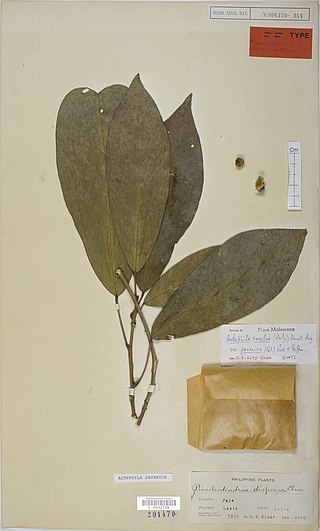
Antidesma is a genus of tropical plant in the family Phyllanthaceae formally described by Linnaeus in 1753. It is native to tropical Africa, S + E + SE Asia, Australia, and various oceanic islands. The greatest diversity occurs in Southeast Asia.

Mallotus is a genus of the spurge family Euphorbiaceae first described as a genus in 1790. Two species are found in tropical Africa and Madagascar, while all others are found in East Asia, the Indian Subcontinent, Southeast Asia, eastern Australia, and certain islands of the western Pacific. The genus has about 150 species of dioecious trees or shrubs.

Phyllanthus is the largest genus in the plant family Phyllanthaceae. Estimates of the number of species in this genus vary widely, from 750 to 1200. Phyllanthus has a remarkable diversity of growth forms including annual and perennial herbs, shrubs, climbers, floating aquatics, and pachycaulous succulents. Some have flattened leaflike stems called cladodes. It has a wide variety of floral morphologies and chromosome numbers and has one of the widest range of pollen types of any seed plant genus.

Macaranga is a large genus of Old World tropical trees of the family Euphorbiaceae and the only genus in the subtribe Macaranginae. Native to Africa, Australasia, Asia and various islands of the Indian and Pacific Oceans, the genus comprises over 300 different species. It was first described as a genus in 1806, based on specimens collected on the Island of Mauritius.

Hancea integrifolia is a plant species in the family Euphorbiaceae. It is native to Mauritius and Réunion.

Blumeodendron is a genus of dioecious trees of the family Euphorbiaceae first described as a genus in 1873. It is widespread across much of Southeast Asia and Papuasia.

Beyeria is a genus of shrubs and small trees in the family Euphorbiaceae known as turpentine bushes. It was first described as a genus in 1844. The entire genus is endemic to Australia.

Baccaurea is a genus of flowering plants belonging to the family Phyllanthaceae. The genus comprises 51 species, distributed from India to Indochina, southern China, Malesia, New Guinea, and the West Pacific. It is dioecious, with male and female flowers on separate plants. Many species contain edible fruits.

Breynia is a genus in the flowering plant family Phyllanthaceae, first described in 1776. It is native to Southeast Asia, China, Réunion, the Indian Subcontinent, Papuasia and Australia.

Glochidion is a genus of flowering plants, of the family Phyllanthaceae, known as cheese trees or buttonwood in Australia, and leafflower trees in the scientific literature. It comprises about 300 species, distributed from Madagascar to the Pacific Islands. Glochidion species are used as food plants by the larvae of some Lepidoptera species including Aenetus eximia and Endoclita damor. The Nicobarese people have attested to the medicinal properties found in G. calocarpum, saying that its bark and seed are most effective in curing abdominal disorders associated with amoebiasis.
Synostemon is a genus of flowering plants in the family Phyllanthaceae. It includes 36 species which range from India through Indochina and southeastern China to Malesia, New Guinea, and Australia.

Actephila is a genus of about 36 species of flowering plants in the family Phyllanthaceae native to Southeast Asia, China, the Himalayas, Papuasia and northern Australia. Plants in the genus Actephila are monoecious trees or shrubs with entire leaves that are usually arranged alternately along the branches, flowers arranged singly or in clusters in leaf axils usually with 5 sepals and petals.

Mallotus repandus, known in Australia as the climbing mallotus, is a species of plant in the spurge family Euphorbiaceae. It is native to the Indian subcontinent, mainland Southeast Asia, Malesia, New Guinea, Queensland, New Caledonia and Vanuatu.
Mallotus plicatus is a tree or shrub in the Euphorbiaceae family, in the Polyadenii section. It occurs in much of Mainland Southeast Asia. It is used for dyeing and in construction.
Mallotus floribundus is a tree in the family Euphorbiaceae, in the Stylanthus section, native to Southeast Asia, Wallaceae, New Guinea and the Solomon Islands.
Spathiostemon moniliformis is a plant that can grow as a shrub or a tree in the Euphorbiaceae family, Acalypheae tribe. It is endemic to southern/peninsular Thailand.












